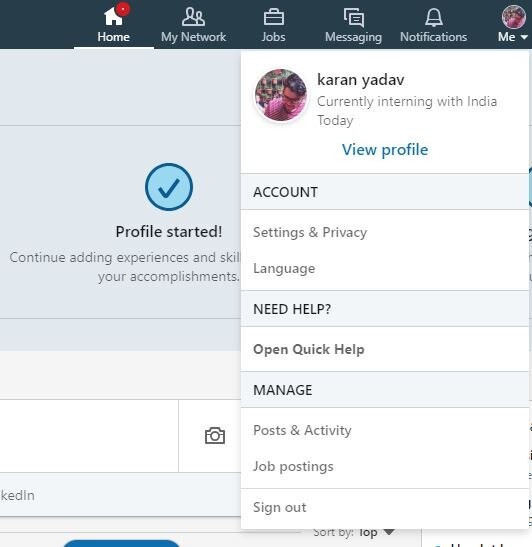Deactivating your LinkedIn account can feel daunting, especially if you've been using it for years. Whether you're looking to take a break from social networking or simply want to declutter your online presence, the process is straightforward. In this post, we will guide you through the steps to unsubscribing and deactivating your LinkedIn account. It's all about regaining control over your online identity and ensuring that your digital footprint reflects your current needs and preferences.
Reasons for Wanting to Unsubscribe from LinkedIn
Many users find themselves contemplating whether to unsubscribe from LinkedIn for various reasons. Here are a few common motivations:
- Privacy Concerns: With increasing awareness around data privacy, many individuals feel uncomfortable having their professional information accessible online. Deactivating your account can give you peace of mind.
- Notifications Overload: LinkedIn can sometimes overwhelm users with notifications, from job offers to connection requests. If you're getting more alerts than you can handle, it might be time to step back.
- Career Changes: If you're shifting industries or considering a career path that doesn't rely on LinkedIn networking, you may no longer find the platform relevant to your goals.
- Time Management: Social media can be a major distraction. Taking a break from LinkedIn might help you refocus on personal projects or responsibilities.
- Unused Profile: If you created your LinkedIn profile years ago but haven't actively used it, you might wonder why it’s still there. Deleting unused accounts can streamline your online presence.
When considering these reasons, it's essential to weigh the pros and cons of leaving the platform. For some, LinkedIn is a vital career tool; for others, it can feel more like a burden. Understanding your motivation for wanting to unsubscribe will help you make a more informed decision about your digital footprint.
Also Read This: Can I Temporarily Deactivate My LinkedIn: How to Temporarily Deactivate Your LinkedIn Account
3. How to Access Your LinkedIn Account Settings
Alright, you’ve decided to take a break from LinkedIn, but before you can say goodbye, you need to get into your account settings. Don’t worry; it’s a piece of cake! Just follow these simple steps, and you’ll be navigating the settings like a pro.
First things first, you need to log into your LinkedIn account. If you’ve been away for a while, your memory might be a bit rusty, but just head over to the LinkedIn website or app and enter your login credentials. Once you’re in, let’s find those settings!
Next, look for your profile picture, which is usually tucked away in the top right corner of the screen. Clicking on it will reveal a drop-down menu with several options. From here, you’ll want to click on “Settings & Privacy”. This is your gateway to managing everything about your account, from privacy settings to communications preferences.
In the Settings & Privacy section, you’ll see different tabs on the left side of the page. Each tab contains various options that cater to your needs:
- Account Preferences: Manage your account information, control what’s in your profile, and more.
- Privacy: Adjust who can see your connections, profile visibility, and other privacy-related settings.
- Communications: Control how you receive messages, notifications, and invitations.
Take some time to explore these options. It’s a good chance to reconsider how you share your presence on LinkedIn before you deactivate your account. However, if you’re sure about stepping away, let’s move on to the next section and get you through the deactivation process!
Also Read This: How to Disconnect from Someone on LinkedIn
4. Steps to Deactivate Your LinkedIn Account
Now that you’ve accessed your account settings, it’s time to dive into the process of deactivating your LinkedIn account. Take a deep breath; I promise it’s not as daunting as it sounds. Just follow these steps, and you’ll be one step closer to your break from LinkedIn!
1. *Go to the Settings & Privacy page:
If you’ve followed the previous section, you should still be in your account settings. If not, simply follow the steps again to get there.
2. Locate the Account Management section:
On the left sidebar, you will see different tabs. Look for the “Account preferences” tab, and click on it. Scroll down until you find the “Deactivate your account” option.
3. Understand the implications:
LinkedIn will present you with some information about deactivation. It’s important to read through these details because they clarify what deactivation means. Essentially, you’ll lose access to your account and will not be searchable on the platform.
4. Select a reason for deactivation:
LinkedIn will ask you to select a reason for your account deactivation. This could be anything from wanting a break to concerns about privacy. Pick whatever resonates most with you—it’s just a formality!
5. Confirm your deactivation*:
Finally, once you’ve made your choice, click on the button that confirms your decision to deactivate your account. LinkedIn may ask for your password to verify it's really you making this choice. Enter your password, and voilà—you’re on your way to deactivation!
And that’s it! You’ll receive a confirmation that your account has been deactivated. If you ever decide to return, LinkedIn allows you to reactivate your account with just a few clicks. So, take your time, enjoy your break, and remember that LinkedIn will be waiting for you whenever you’re ready to hop back in!
Also Read This: How to Add Badges to LinkedIn for Enhanced Professional Credibility
5. What Happens After Deactivation
So you've decided to deactivate your LinkedIn account. First off, good for you! Taking a step back from online platforms can sometimes be just what you need. But you might be wondering, what exactly happens after you hit that "deactivate" button?
When you deactivate your LinkedIn account, it is essentially put on hold. This means:
- Your profile is hidden: Your profile and any public information linked to your account will no longer be visible to others. This includes your connections, your public profile, and any shared content.
- You lose access: You won't be able to log into your account or access any of your messages, connections, or posts.
- Data retention: LinkedIn retains your information for a significant period. This is important if you decide to reactivate your account in the future. All your data, such as connections and settings, will be saved.
- Notifications stop: Say goodbye to those endless notifications! Once deactivated, you’ll stop receiving emails or updates from LinkedIn.
However, keep in mind that deactivation doesn't mean your data is gone. It’s merely a temporary break, and if you decide to come back later, the process of reactivation is straightforward.
But just how long does it last? Well, LinkedIn does not specify a strict timeframe for account deactivation. Your account can stay deactivated as long as you want! If you think you might return, just remember that your data is still “on hold” for you.
If you’re uncertain about your decision, consider that you can also just reduce your activity on the platform instead of deactivating entirely. Adjusting your settings to limit notifications and appearance can sometimes provide the break you need without completely stepping away.
Also Read This: Adding LinkedIn to Your Resume: Placement and Formatting Tips
6. How to Completely Delete Your LinkedIn Account
If you’ve made the tough decision to move on from LinkedIn altogether, you have the option to delete your account permanently. This is a more final step than deactivation, so let’s ensure you know exactly how to do this and what to expect.
Here’s a straightforward guide on how to completely delete your LinkedIn account:
- Log into Your Account: First, head to LinkedIn and log in. You'll need to be connected to your account to perform this action.
- Access Account Settings: Click on your profile icon at the top right corner and select “Settings & Privacy” from the dropdown menu.
- Find Account Management: In the Settings menu, navigate to the “Account preferences” section. Here, you’ll find an option for “Close your account.”
- Select a Reason: LinkedIn will prompt you to select a reason for your departure. This is optional, but providing feedback can help improve the platform.
- Confirm Deletion: After you've selected a reason, click on the “Next” button. You’ll be asked to confirm again that you want to delete your account. It may feel like they really want to make sure you want to do this!
- Final Confirmation: LinkedIn may require you to enter your password one last time to confirm your identity. Once you do that, click “Close account.” And voila!
Keep in mind, once you delete your account, all your data, connections, and any endorsements or recommendations are gone forever. It’s a permanent action, so think it through carefully.
After deletion, it might take a short while for your profile to completely disappear from the platform. In some cases, your data may still be present in LinkedIn’s backend for a specific duration due to their data retention policies, but it won’t be accessible to anyone.
Congrats on taking this step, if you choose to go through with it! Whether you’re trying to declutter your online presence or just taking a break from professional networking, it’s always good to evaluate how these platforms affect your well-being.
Also Read This: Can You Edit a Post on LinkedIn After Publishing? What You Need to Know
7. Reactivating Your LinkedIn Account
If you've decided to take a break from LinkedIn but are now contemplating returning to the platform, you're in luck! Reactivating your LinkedIn account is a straightforward process, and it can often be done in just a few clicks. Here’s how to navigate this easy-peasy step:
- Log Back In: Start by visiting the LinkedIn website or opening the app. Simply enter the email address and password associated with your old account. If you've forgotten your password, LinkedIn has a recovery option that will help you reset it.
- Follow the Prompts: Once logged in, LinkedIn may ask you to confirm your identity through a verification step. This could involve receiving a code via email or text—just follow the prompts!
- Check Your Profile: After regaining access, take a moment to review your profile. Your information, connections, and messages should all be intact, but it’s good to update any outdated details or notifications.
- Adjust Privacy Settings: Before you dive back into the professional networking world, consider updating your privacy settings. You might want to control who sees your activity or the information shared on your profile.
- Reconnect and Explore: Now that your account is reactivated, you can start reconnecting with colleagues, joining groups, or following new companies that pique your interest. LinkedIn is continuously evolving, so you'll likely find new opportunities and features waiting for you!
Keep in mind that if your account has been deactivated for an extended period, there may be some limitations regarding data retention. Be sure to read any notifications from LinkedIn regarding your account status and take action as necessary. Happy networking!
Also Read This: What Do the Green Dots on LinkedIn Mean? Understanding Activity Indicators
8. Alternatives to Deactivation
You might not want to fully deactivate your LinkedIn account but still feel the need to take a step back. Fortunately, there are several alternatives that provide a good balance between preserving your presence and reducing your activity on the platform. Here are some options to consider:
- Adjust Privacy Settings: Instead of deactivating your account, you can customize your privacy settings. Set your profile visibility to private, control who can see your connections, and limit who can view your activity. This way, you can enjoy a quieter LinkedIn experience while still maintaining your account.
- Limit Notifications: Turn off email notifications or adjust your preferences so you’re not bombarded with alerts about job postings, connection requests, or posts by your network. You can do this easily in the settings section, allowing you to engage on your own terms.
- Pause Your Activity: Taking a break from posting or participating in discussions can also be a way to disengage without losing your account. Simply step back from liking posts, commenting, or sharing, and let your profile sit while you recharge.
- Archive Your Data: If you're concerned about your personal information or don’t want your profile to be visible, consider downloading your LinkedIn data and then modifying your profile to limit the information displayed. This gives you control over what people see when they search for you.
- Explore Alternative Networks: If you’re moving away from LinkedIn due to its corporate feel, perhaps explore other social platforms. Sites like Alignable, Meetup, or even Facebook Groups can be less formal alternatives where you can connect with professionals in a more relaxed atmosphere.
By considering these alternatives, you can tailor your LinkedIn experience to better suit your needs without the need for a complete deactivation.
Conclusion: Making the Right Choice for Your LinkedIn Presence
Deciding to unsubscribe or deactivate your LinkedIn account is not a decision to be taken lightly. It's essential to consider both your current professional needs and future opportunities. Keeping a presence on LinkedIn can offer numerous benefits:
- Networking opportunities with industry professionals
- Access to job listings and recruitment resources
- A platform to showcase your expertise and achievements
- Ability to keep up with industry trends and insights
However, if you find that you are not utilizing the platform, or if it contributes to stress or distracts you from your goals, deactivating your account could be a beneficial step. Consider the following:
| Reasons to Stay | Reasons to Leave |
|---|---|
| Active job search or career advancement | Feeling overwhelmed by notifications and updates |
| Building a professional network | Limited engagement with content |
| Recruitment opportunities | Privacy concerns or data usage apprehensions |
In conclusion, weigh the pros and cons carefully when deciding to unsubscribe or deactivate your LinkedIn account. It's crucial to align your decision with your career goals and personal well-being, ensuring that whichever choice you make is right for your professional journey.

 admin
admin








